Day 1 Shanghai → Addis Ababa Reference Flight: ET685 0020-0600
All day
Then take a flight to Windhoek, the capital of Namibia.


Day 2 Addis Ababa → Windhoek Reference flight: ET835 08:35--13:20
All day
After arriving in Windhoek, a professional Chinese tour guide will pick you up at the airport and take you to the hotel for rest.
In the afternoon, we went to the city center to take photos of the iconic building, Christ Church (exterior), and climbed up to the 4th floor of the museum opposite to overlook Windhoek from a private camera.
Windhoek, nestled in Namibia's central highlands at an altitude of 1,728 meters, is surrounded by mountains to the south, north, and west, with many buildings nestled against the hills. This small yet vibrant city boasts a diverse architectural style and numerous well-preserved historical buildings, making it a prime destination for scenic photography.
After filming, we headed to the renowned local restaurant Joe's Beerhouse for a welcome meal of German pork knuckle. This German-owned restaurant, featured on the popular variety show "Flowers and Youth," is a popular spot and bustling with people from China and abroad, enjoying the lively atmosphere. After dinner, we checked into our hotel to rest.
[Warm Tips]: During free time, please be sure to travel with a companion and return to the hotel as soon as possible. Be careful not to expose your belongings.


Day 3 Windhoek → Photographing Cheetahs → Quiver Tree Manor
All day
Depart at the appropriate time and drive to China-TravelNote's specially arranged Cheetah Manor for lunch. The drive takes approximately 3-4 hours. After lunch, you will be allowed to enter the park to photograph the cheetahs up close and capture precious images.
We'll then drive to the Quiver Tree Estate in southern Namibia. The quiver tree, actually an aloe barbadensis tree, reaches heights of 5-6 meters. It's named after the locals who often hollow out their branches to use as quivers. At night, try stargazing. Capturing Namibia's dazzling stars against the backdrop of a cluster of quiver trees is a classic photo spot. British photographer Florian Breuer captured his famous work "Quaver Trees Under the Stars" here. If the moon is full or weather conditions are poor, light painting sessions can be arranged.
Note: Star photography is a complimentary service and is subject to weather conditions. If it is a full moon day, light painting will be arranged. Please note that there will be no refunds if you cannot participate due to weather or personal reasons.
[Special Note 1]: If there are no rooms in the park during the peak season, you can choose to stay in a hotel in the nearby area, but this will not affect the filming.
[Special Note 2]: Activities such as taking photos with cheetahs have been cancelled throughout Namibia.


Day 4 Quiver Tree Manor → Sossusvlei Desert (camping in the park)
All day
If you get up early, you can choose to enter the Quiver Woods again to take pictures of the sunrise.
After breakfast, we'll depart for a photoshoot in the Sossusvlei Desert. Within the vast 54,000 square kilometers of the Namib Desert, the Sossusvlei Desert stands out as a striking sight. Its towering crimson dunes contrast beautifully with the blue sky and white clouds, creating a stunning photo opportunity that's sure to draw countless likes, no photo editing software needed.
I came to Dune 45 just in time for my creative endeavors. If the Sossusvlei Red Desert is the most striking feature of the Namib Desert, then Dune 45 is undoubtedly its most striking landmark. Dune 45 maintains a captivating S-shaped curve. Under the sun, the side facing the sun is a dazzling crimson, while the side facing away from the sun is a deep, solemn color. The two colors create a sharp contrast at the intersection of the ridges. Every curve, every flicker of light and shadow, is a fascinating subject for photographers.
[Special Note] According to the regulations of the Namibian government, tourist buses must enter the Red Desert National Park after sunrise and exit at sunset.


Day 5 Death Valley → Solitaire → Whale Bay
All day
Get up early and transfer to a four-wheel drive off-road vehicle in the Red Desert Scenic Area to visit the Namib Desert's unique wonder of life, the Death Basin, to photograph the thousand-year-old trees.
Death Basin is a world-renowned natural heritage site. Within the basin, the centuries-old dead camel trees stand alone, a desolate and majestic sight. The remnants of the former riverbed mud on the ground, set against the layers of red sand dunes and blue sky, create a striking contrast that is unforgettable.
We'll then transfer to Whale Bay via Solitaire. Solitaire is a world of cacti and classic cars, nestled amidst the vast wilderness, where bizarre cacti grow and a variety of classic cars are scattered around. The unique African landscape exudes a strong Western vibe!
After a transfer, we arrived at Walvis Bay, a symphony of sand and sea. Half of Namibia's life is in the desert, and the other half is in the ocean. Walvis Bay, a port city in Namibia, is where the ocean and desert meet. A visit to Walvis Bay reveals the stark contrast between water and fire: on one side, the year-round dry desert, and on the other, the cold, surging ocean. The stark contrast will leave you marveling at the wonders of nature. Walvis Bay is also home to a large number of sea lions and a variety of seabirds, including pelicans and seagulls. If you're lucky, you might even encounter and photograph flamingos!!!
[Special Note] According to the regulations of the Namibian government, tourist buses must enter the Red Desert National Park after sunrise and exit at sunset.


Day 6 Whale Bay (Whale Bay sailing + sand washing + flamingo painting)
All day
After breakfast, we'll start our day full of energy, preparing for our Whale Bay excursion! Snacks, fresh Namibian oysters, liquor, soft drinks, and more will be provided throughout the trip.
There is a natural harbor covering 100 square kilometers. As soon as the boat set sail, we were quickly surrounded by various marine life. Pelicans and seagulls might fly around us along the way, and we enjoyed taking pictures.
During the cruise, you'll see the sandy beaches of Pelican Point, home to the fur seals. They've been our friends for years and might even come to play on the deck. July to October is the migration season for Humpback right whales, giving us the chance to see these remarkable creatures.
In the afternoon, we'll embark on another exciting excursion: Sandboarding at Whale Bay and Sandwich Bay. With the Atlantic Ocean on one side and the world's tallest sand dunes on the other, we'll capture the unparalleled spectacle of sand flowing into the sea! The desert stretches to the ocean, and the ocean flows into the desert, creating a magnificent symphony of sand and sea. Imagine speeding through the water in an off-road vehicle while taking in the action! Along the way, we'll pass a shallow beach, home to a flamingo habitat. We'll search for and photograph the beautiful flamingos, concluding our tour around 5 PM.


Day 7 Whale Bay → Spitzkoppe (Arch Starry Sky)
All day
After breakfast, we'll continue to the beach to photograph flamingos. We'll then drive to Spitzkoppe (Namibia's Arch), a sacred mountain that resembles the world-famous Spitzkoppe Arch in the western United States. The scenic area includes a large private reserve where you can hike, stargaze, and more.
After arriving in the afternoon, we will visit the Shenshan Scenic Area, which is also the local sacred mountain of love. Many people come here specifically to propose marriage. If we are lucky, we can use the camera to record this romantic moment in front of the arch!
In the evening, we traveled to Mount Kinabalu to photograph the Southern Hemisphere Arch starry sky. The dry air, comfortable temperature, and pitch-black surroundings gave us a chance to create under the night sky. As a UN-designated Gold-level dark sky reserve, the starry skies and Milky Way here are sure to leave you with an unforgettable experience! We camped in tents at a campsite within the scenic area, which is currently the only way to photograph Mount Kinabalu.
Note: Star photography is a complimentary service and is subject to weather conditions. If it is a full moon day, light painting will be arranged. Please note that there will be no refunds if you cannot participate due to weather or personal reasons.


Day 8 Spitzkoppe Mountain → Red Clay Man Tribe → Etosha Park Hotel
All day
Get up early to take pictures of the morning light at Mount Spitzkoppe, and then go to the Red Clay Man Tribe to take pictures.
The Himba tribe, a remote region of Africa, remains a pristine people, maintaining a lifestyle that dates back over 500 years. The Himba live in thatched huts in the jungle, with men herding and hunting outside while women tend to household chores and raise children. Ethnic cultural traditions evolve with the development of civilization, and some cultural phenomena eventually become part of history and disappear in reality. Perhaps in ten years, we'll only be able to see the Red Mud Tribe in recorded footage or at tourist attractions.
Then we will go to Etosha and check into a hotel outside the park to rest.
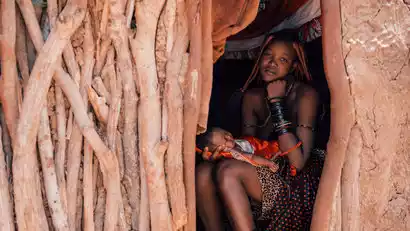
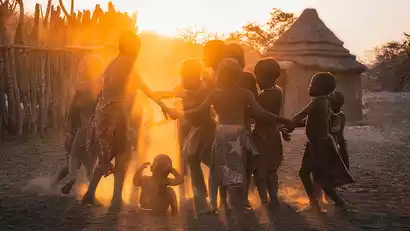
Day 9 Etosha National Park (full day game drive)
All day
Today we will enter Namibia's famous Etosha National Park for filming, which can be regarded as one of the highlights of this trip.
Etosha, which translates to "Great White Place" in the Ovambo language, is named after the Etosha Pan, a vast white salt pan within the park that spans 130 kilometers long, 50 kilometers wide, and covers an area of 4,800 square kilometers. Apart from the pan, most of the park is covered in tropical savannah woodland.
This is one of Africa's largest and most important wildlife reserves. Most of the time, it's dry, with only a few rainwater ponds scattered across Etosha like pearls, providing life-saving water for animals. To survive, animals must travel great distances to distant ponds for water. However, during the abundant summer rainy season, water accumulates, forming pools of varying sizes, attracting a large number of animals. These ponds offer a feast for the senses, perfect for capturing wildlife.
[Special Note 1] According to the regulations of the Namibian government, tourist buses must enter the national park after sunrise and exit at sunset.
[Special Note 2] The whereabouts of wild animals cannot be accurately tracked, and the specific animals that can be seen cannot be confirmed. Please refer to actual behavior.
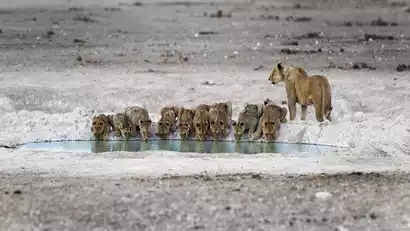
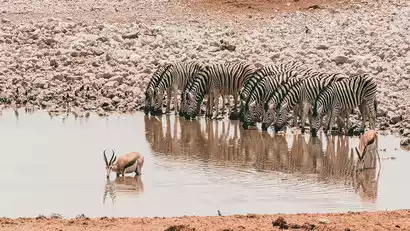
Day 10 Etosha → Windhoek
All day
After breakfast at the hotel, we'll visit a nearby waterhole to photograph the animals drinking in the morning water. We'll then return to Windhoek in due time. Enjoy a light lunch en route before driving back to Windhoek. After dinner in Windhoek, we'll check into our hotel and rest.
[Special Note 1] According to the regulations of the Namibian government, tourist buses must enter the national park after sunrise and exit at sunset.
[Special Note 2] The whereabouts of wild animals cannot be accurately tracked, and the specific animals that can be seen cannot be confirmed. Please refer to actual behavior.
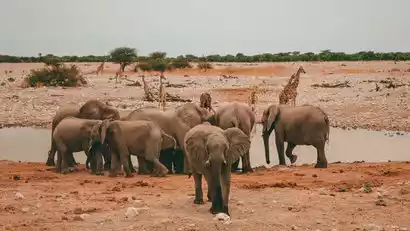
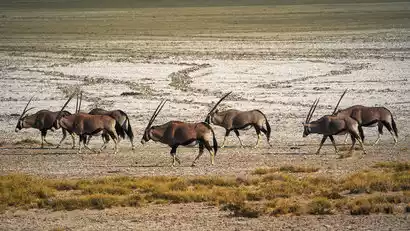
Day 11 Windhoek → Addis Ababa Reference flight: ET834 14:30--21:20;
All day
After breakfast, we'll be transferred to the airport to board our international flight back to Shanghai (with a layover). This marks the end of our wild and enjoyable photography trip to Namibia.
Day 12 Addis Ababa-Shanghai Reference Flight: ET684 2330 1545
All day
Today is our disbanding day. All the tourists are still reluctant to leave and say goodbye with tears in their eyes.
After you return, remember to fill out a follow-up review on the "China-TravelNote APP" to win a cash voucher. You can also share the wonderful memories of your trip on the "China-TravelNote Community" & "China-TravelNote Photography Network"!






